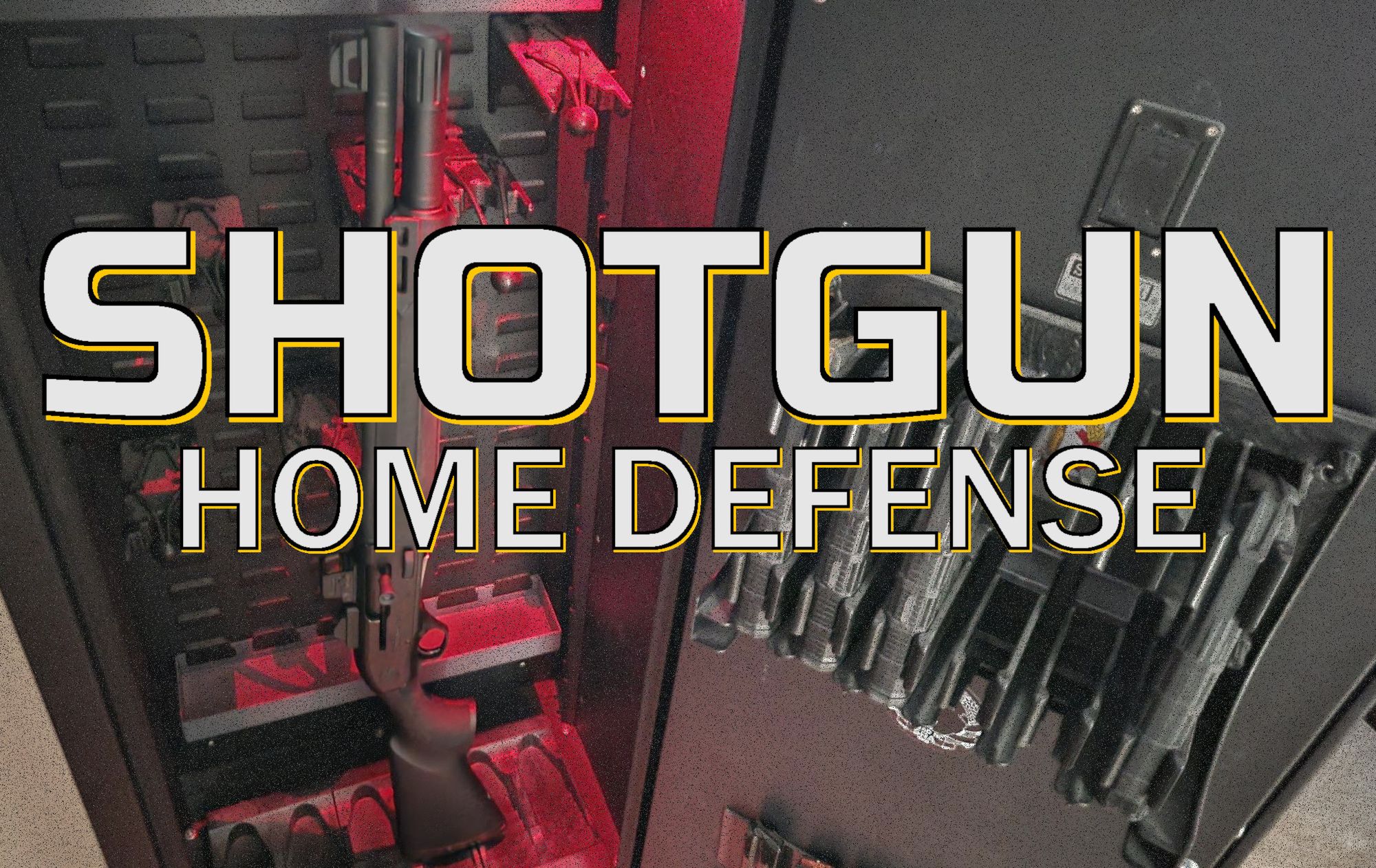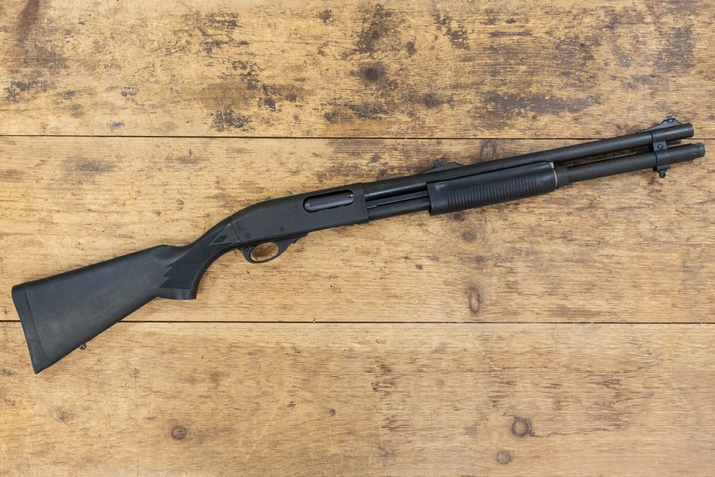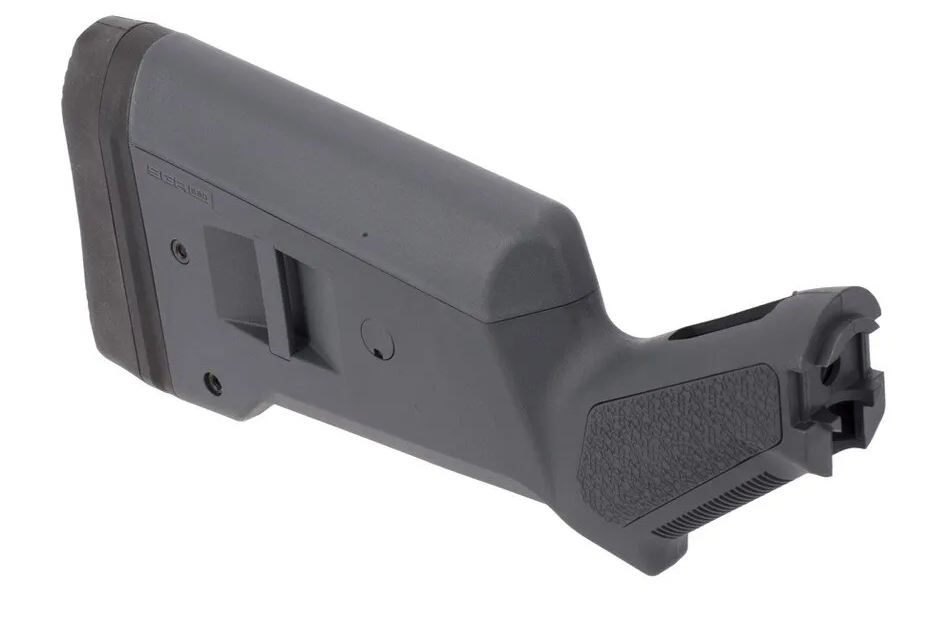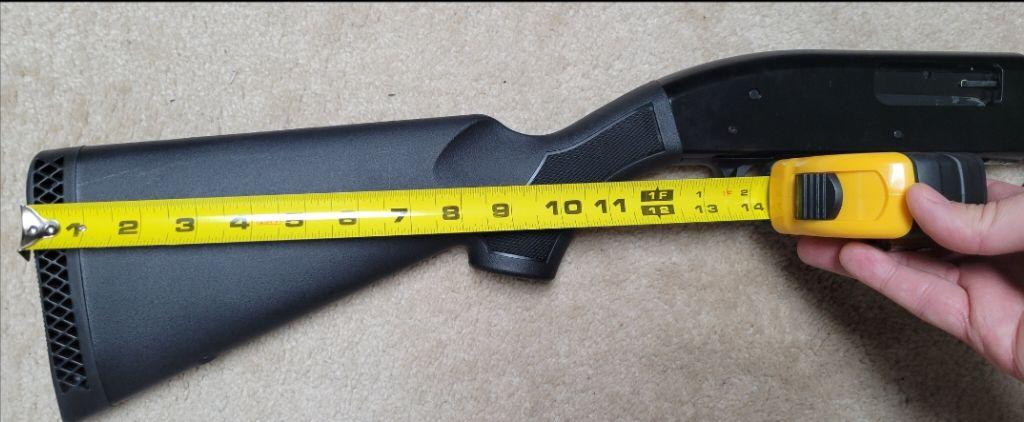The Case for the Home Defense Shotgun
While we always recommend a striker fired handgun to be the first purchase for almost every new gun owner due to sheer utility, the selection of a home defense firearm can be a little more complicated.

Legal Disclaimer: While general legal perspectives and theories are shared in this article, this article does not constitute legal advice. If you have specific legal questions, you should consult with an attorney.
With another presidential election cycle coming to a close, we're seeing another wave of new left of liberal firearms owners taking their personal defense seriously. While I always recommend a striker fired handgun to be the first purchase for almost every new gun owner due to sheer utility, the selection of a home defense firearm can be a little more complicated. While we select a handgun for our personal defense outside of the home due to the necessity of concealment – no, you will not be able to deploy your backpack-stowed pistol caliber carbine or folding-stock rifle in time to defend yourself – we typically have more options for a home defense weapon.
Assuming the prepared defender already has a handgun, a long gun for home defense is typically a good choice if it can be safely stored and deployed quickly when needed. A rifle or shotgun will have immensely greater stopping power versus a handgun and the presence of a stock will make the weapon more accurate. This article will focus on the advantages and disadvantages of selecting a shotgun for home defense.
Advantages of the Home Defense Shotgun
Cost. The cost of a quality 12-gauge pump-action shotgun is almost always going to be significantly lower versus a quality AR-15. Additionally, the cost to get the gun up and running as a home-defense firearm is going to typically be lower for a shotgun. While bead sights are the worst of the options available for shotguns they still come standard on even the lowest tier budget blaster; many budget-tier AR-15's or AR-15's built from a lower receiver and upper receiver on sale don't come from the factory with iron sights.

Remington 870 Police Magnum 12-gauge trade-ins can often be found for under $400 and can become serviceable again as a home defense shotgun for minimal cost. Photo Credit: sportsmansoutdoorsuperstore.com
Legality. In states that specifically ban features commonly found on the AR-15, the 12-gauge shotgun will still be legal. Additionally, in studies involving mock juries, prison sentences for home defense cases involving an AR-15 were higher than any other type of weapon involved in the study:
“Importantly the average recommended sentence when the homeowner used the AR-15 weapon was 7.2 years for male subjects and 8.5 for females. This was significantly higher than any of the other gun types. The handguns had the lowest recommended sentences (in the two to four year range).”1
If a prepared defender was actively involved in political organizing that was unpopular in their county and subsequently attacked at home as a reprisal, the decision of a potentially biased jury could be significantly altered by the type of firearm used. Keep in mind that the average person selected for a jury pool does not understand firearms beyond what they see in movies and on television. While being charged in a use of force incident when being attacked inside the home is unlikely, perceived legality does remain a factor.
Additionally, a spouse, partner, room mate, or family member who may be uncomfortable with an AR-15 in the home due to media bias against the platform may otherwise begrudgingly accept having a shotgun in the home for defense.
Ergonomics. Assuming the defender keeps their 12-gauge shotgun “closet ready”, the basic act of firing a shotgun is fairly similar to other firearms. Your stance should be similar to the stance you employ when firing a handgun or a carbine. Your index point for keeping your trigger finger on bare metal when you have not yet made the decision to fire will be similar to the slide on the handgun or the receiver of an AR-15. The only major differences will be running the pump on a pump-action and reloading, which will require additional training and practice. We will be discussing the definition of closet ready later in the article.
Lethality. While terminal ballistics of rifles will always trump handguns, the imperialist invasions of Afghanistan and Iraq taught the US military about the limitations of the .223/5.56mm round. Soldiers being trained to engage targets often found it necessary to return to the same target and fire again as the M855 round would pass through soft tissue before yawing or fragmenting.2 While there is far superior ammunition available now to civilians than the M855 round the US military had in the early 2000's, the properly loaded shotgun remains superior in lethality to both the rifle and the handgun at pistol-fighting distances.
In a gun fight, determined assailants are stopped by either shutting down the electrical system or the hydraulics. The energy delivered from a properly loaded shotgun aimed at high center mass is more likely to overwhelm the central nervous system with one shot via multiple strikes to significant organs and arteries. Simply put, a single round of 8 pellet 00# buckshot is the ballistic equivalent to emptying a single stack magazine handgun with one trigger press.

Rio Royal 9 Pellet 00# buckshot out of a Remington 870. Photo Credit: LuckyGunner
Ammunition. Even during the height of pandemic ammunition scarcity, 12-gauge ammunition was typically available in retail stores. Shotguns are one of the most common firearms in the United States and ammunition is often plentiful, even if it's not the best type of ammunition for your use case.
Disadvantages of the Home Defense Shotgun
Ammunition. How can ammunition be both an advantage and a disadvantage to owning a shotgun? Unfortunately, most of the research and development for shotgun ammunition has either been done on behalf of law enforcement or the US military. This had led to a few issues: there is almost zero viable self-defense shotgun ammunition available for anything other than the 12-gauge and while there may be three or four viable brands and loads of self-defense ammunition for pistol calibers and rifles, there is really only one viable home defense load for the shotgun. While proper selection of quality self-defense or carry loads are vitally important to handguns and rifles used for personal protection, this is even more critical with the shotgun.
Federal FliteControl 12-gauge 8 Pellet 00# Buckshot is the hands-down best option for a home defense shotgun. Buckshot always performs better when stacked with eight pellets versus nine pellets – physics involving uneven stacking of nine pellet buckshot causes more flattening and bouncing around of the pellets, leading to a phenomenon known as “the ninth pellet flier.” The ninth pellet flier can bypass an intended target and maim or kill an innocent bystander. FliteControl Buckshot stays remarkably in-tact out to 15 or 20 yards before the pellets begin spreading due to the nature of the FliteControl Wad. While Hornady Critical Defense 00# buckshot uses the same patented Versatite wad as FliteControl, their version tends to peel apart in the barrel and is a distant second to Federal's offering. Hornady's Critical Defense buckshot is also not plated, which leads to more deformation and flat spots on the lead pellets in mid-flight.
Federal FliteControl can be difficult to find on store shelves and generally needs to be purchased online. When it can be found in stock online, it's typically more expensive than most other buckshot.
Accessories and Setup. Adding a red-dot optic to a shotgun is going to typically be more difficult than adding one to an AR-15 and will usually require either drilling/tapping the receiver for a rail or buying an optic plate. Upgrading from a bead sight to a ghost ring or pistol-style sights is going to require a trip to the gunsmith or a blowtorch.

The Magpul SGA Stock has an adjustable length of pull from 12.3-14.3.”

The Mossberg Maverick 88, a popular budget-tier option, comes equipped with a stock that is generally too long for defensive use.
Additionally, one of the major problems with defensive shotguns involves length of pull. Most tactical and defensive shotguns are simply sporting shotguns with added features and black polymer furniture. Beretta has recently gotten this right with their A300 and 1301 shotguns which come from the factory with the proper length of pull. The most important modification to do to a shotgun being used for home defense is to shorten the stock from 13” or 14” down to 12-12.5” which will either require purchasing a compatible Magpul SGA stock or paying a gunsmith a nominal fee to cut or shave down the stock.
Maintenance. Home defense shotguns require greater maintenance versus rounds fired compared to a handgun or most carbines. Plastic shotgun shells will leave streaks of molten plastic in a shotgun barrel over time, which can dramatically affect patterning and encourage rust to form. Mounted red dot optics and lights will take more of a beating from recoil and will need to be checked more often. Additionally, if a home defense shotgun is left loaded in a closet ready configuration, the magazine tube spring should be replaced annually as these springs are much thinner and more fragile than the springs found in pistol and rifle magazines.
Recoil. It would be intellectually dishonest if I were to fail to mention the dramatic recoil of 12-gauge buckshot versus a 9mm handgun or an AR-15 pattern rifle. While recoil can be dramatically mitigated for even the smallest framed shooter with proper push-pull technique, this is much more difficult for someone with physical disabilities especially those affecting the upper body or joints. Assuming the shooter is otherwise able-bodied, they should seek formal instruction on push-pull technique and recoil management with the shotgun.
Training. Virtually all indoor ranges ban birdshot and buckshot from being fired due to potential damage to the facility and many ban shotguns outright. While slugs fired from a shotgun are going to provide a very similar experience to 00# buckshot and are allowed at some indoor ranges, they are also more expensive to train with than other calibers. If the prepared defender lacks regular access to a range that allows shooting a shotgun, training will be much more difficult. Training on reloads will also be much more important for home defense versus with an AR-15.
Additionally, the chosen defensive load will absolutely need to be patterned at various distances to determine the maximum range at which the shotgun will be effective. If the shooter lacks access to a range that allows firing 12-gauge buckshot, this will be a major problem.
Suppressors. The ability to suppress an AR-15 greatly adds to its utility as a home defense weapon. While shotgun suppressors are commercially available, they are typically cumbersome, incredibly expensive, and require that the shotgun be able to receive a choke in order to mount. Under the National Firearms Act, a shotgun barrel must be at least 18” versus a rifle barrel coming in at 16” without registering the firearm as a short barreled shotgun. Adding a suppressor with that extra two inches of barrel length will make the shotgun fairly cumbersome for home defense without paying for the additional tax stamp to cut the barrel down to be more manageable.
Negligible and Non-Factors
Capacity. A 12-gauge defensive shotgun with a four-round magazine tube can typically take a +2 extension and hold additional rounds on either a butt-cuff or side saddle. That would have the shotgun with an initial capacity of six with potentially four or more rounds available as reloads. While proper training is required to keep the shotgun topped off during a defensive gun fight, if the problem can't be solved with 10 rounds of 00 buckshot, it probably can't be solved by anything else the defender will be able to do. This is especially relevant when we compare it to the capacity offered by the AR-15 versus the terminal ballistics lessons the US military learned in the Middle East; that “30 round magazine” is in fact more often a 28-round magazine and each assailant will potentially require more than one or two rounds to end the fight.
Racking the Shotgun. One often-repeated knock against the home defense shotgun, ironically also considered a positive from the even less informed, is that the sound of running the pump on a pump-action will give away the position of the defender. During a violent home invasion (which remains a very rare statistical event, to be clear) the defender should be announcing their presence and the fact that they are armed in order to potentially deter invaders from proceeding into the occupied portion of the home. Racking the shotgun may also give a room mate, loved one, or family member an opportunity to announce their presence before being accidentally shot.
Range. The overwhelming majority of home defense gun fights are occurring somewhere between 3 yards and 15 yards. While the AR-15 chambered in .223/5.56mm undoubtedly has a far superior range than the 12-gauge shotgun; the shotgun may boast a maximum useful distance of 40 yards with optimal ammo versus 500 yards or more with a skilled shooter and magnified optic for the AR-15, these are not ranges where a defender can typically articulate the necessity of using lethal force to defend human life.
Drop Safety. Multiple people die every year due to a loaded home-defense shotgun being propped up in the corner of a bedroom falling over and going off or a hunting shotgun leaned up against a fence falling over and killing a hunter. Shotguns are not drop safe and the cross-bolt or thumb-slide safety available on every shotgun sold in the United States is simply a mechanical safety that prevents the trigger from being pulled. There are no additional safeties inside of a shotgun to prevent it from firing which is why defensive shotguns must be kept in a “closet ready”state. Closet ready means that the shotgun is kept with a loaded magazine tube and an empty chamber, preferably hammer down, and with the safety disengaged.
A shotgun stored in this manner can be ready in seconds by simply running the pump on a pump-action model or racking the bolt on a semi-automatic shotgun. While the shotgun not being drop safe is an inherent negative due to its design, this can be mitigated with proper training and handling.
Closing Thoughts
Ultimately, the selection of a long gun for home defense is going to involve multiple factors: legality or perceived legality in your area, cost, utility, and the actual layout of the home. While there are fundamental limitations to the shotgun in regards to distance, capacity and recoil, these limitations can be mitigated with proper training, technique, and ammunition selection. If a new gun owner can only afford one firearm, I still maintain that it should be a striker-fired polymer framed handgun from a sheer utility standpoint. If they own a suitable handgun and can afford a long gun for home defense, a 12-gauge shotgun is absolutely a viable option with proper training and education.
This article has not necessarily been intended to sway a firearms owner away from utilizing an AR-15 or pistol caliber carbine as a home-defense option but merely to present the arguments (while dispelling some myths) for the potential of the shotgun as a home defense tool for the newer gun owner. In the context of a private citizen defending themselves at home, the 12-gauge shotgun has long existed as a viable and economical option. It remains so even today.
1“Will It Hurt Me In Court? Weapons Issues and the Fears of the Legally Armed Citizen” by Glenn E. Meyer, Ph.D
2“Increasing Small Arms Lethality in Afghanistan: Taking Back the Infantry Half-Kilometer” by Major Thomas P. Ehrhart, US Army p. 27-28 https://apps.dtic.mil/sti/pdfs/ADA512331.pdf
